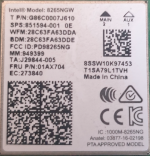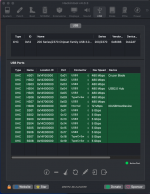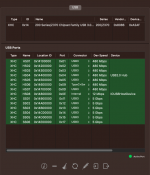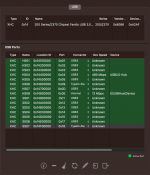Truble getting Bluetooth Working
- Thread starter DAFFY
- Start date
-
Hello Guest. Before you post check the Troubleshooting guide here, Dortania Troubleshooting
You are using an out of date browser. It may not display this or other websites correctly.
You should upgrade or use an alternative browser.
You should upgrade or use an alternative browser.
The chipset showing BCM_4350_2 is that in Hackintool?
Depending on the card in use, some specific kexts and a pair of NVRAM entries are required to get the BT working.
Intel WiFi and Bluetooth are also affected, for the same NVRAM issue plus a couple of other reasons, i.e. no updates to Itlwm or Airportitlwm.kext.
- What's the make and model of WiFi/BT card you are using?
- Which version of macOS have you upgraded from?
- Which if any kexts have you added to your OC setup for the Bluetooth?
- Have you created a USBMap.kext for the system?
- Is the Bluetooth port active in the kext?
Depending on the card in use, some specific kexts and a pair of NVRAM entries are required to get the BT working.
Intel WiFi and Bluetooth are also affected, for the same NVRAM issue plus a couple of other reasons, i.e. no updates to Itlwm or Airportitlwm.kext.
OK, not having the custom USB Map configured is an issue that commonly screws with Bluetooth, as the device is powered over a USB connection.
Moving from Monterey to Ventura shouldn't require any changes for the Intel BT device. As the last major change to the BT stack was when we moved from Big Sur to Monterey. Bluetooth under Ventura and Sonoma should be the same as Monterey.
For Monterey and newer these kexts are required.
If you have added these kexts to your OC setup, then it is probably the lack of a USB Map that is preventing the BT device from working.
From my reading it appears that the HP EliteDesk 800 G3 contains the following USB ports.
Front
1 x Type-C
2 x USB 3
Rear
4 x USB 3
Internal
1 x USB 2 Internal port served from the M.2 WiFi header.
Assuming your system has the same USB port configuration this should be a simple USBPorts.kext to create, as the total number of USB ports will be 15 or 17, depending on the front Type-C port.
If you don't currently use or plan to use the Type-C port it can of course be omitted from the kext. But I would try to map it just to be on the safe side.
Type-c (10) - will show four ports being available, 2 x Type-C and 2 x virtual USB2 ports.
I would strongly recommend you try to create a USBPorts.kext for your system.
You would need to enable the Kernel > Quirks > XhciPortLimit entry in your config.plist and use USBInjectAll.kext (doesn't need to be a new version as this is a Skylake system) so all the ports on the system are available for discovery.
Moving from Monterey to Ventura shouldn't require any changes for the Intel BT device. As the last major change to the BT stack was when we moved from Big Sur to Monterey. Bluetooth under Ventura and Sonoma should be the same as Monterey.
For Monterey and newer these kexts are required.
- IntelBluetoothFirmware.kext
- IntelBTPatcher.kext
- BlueToolFixup.kext
If you have added these kexts to your OC setup, then it is probably the lack of a USB Map that is preventing the BT device from working.
From my reading it appears that the HP EliteDesk 800 G3 contains the following USB ports.
Front
1 x Type-C
2 x USB 3
Rear
4 x USB 3
Internal
1 x USB 2 Internal port served from the M.2 WiFi header.
Assuming your system has the same USB port configuration this should be a simple USBPorts.kext to create, as the total number of USB ports will be 15 or 17, depending on the front Type-C port.
If you don't currently use or plan to use the Type-C port it can of course be omitted from the kext. But I would try to map it just to be on the safe side.
- There are no physical USB2 ports, so none of the ports would be set with connector type USB2 (0)
- There would be a maximum of 12 x ports set with connector type USB3 (3) (2 x each from the 6 physical USB3 ports)
- There would be 1 x port set with connector type Internal (255) (Bluetooth)
- There would be either 2 x ports set with connector type Type-c+sw (9), or 4 x ports set as Type-c (10).
- Insert a Type-C USB pen/drive in to the front port.
- A single USB port will be highlighted in Hackintool or IORegistry Explorer
- Remove the Type-C device, flip the device 180° and reinsert it in the same port.
- If the same port is highlighted, then this is a Type-c+sw port (9)
- If a different port is highlighted, then this is a Type-c port (10)
Type-c (10) - will show four ports being available, 2 x Type-C and 2 x virtual USB2 ports.
I would strongly recommend you try to create a USBPorts.kext for your system.
You would need to enable the Kernel > Quirks > XhciPortLimit entry in your config.plist and use USBInjectAll.kext (doesn't need to be a new version as this is a Skylake system) so all the ports on the system are available for discovery.
Couple of issues as I see things.
You have a total of 16 x USB ports active in the screenshot. You need to drop one port, to keep within the 15 x ports per USB controller limit.
You have 3 x ports set with connector type - Type-c+sw, 2 x physical and 1 x virtual port. Unless your system contains 2 x Type-C external connectors this will be wrong.
If your system only has the single Type-C port on the front of the case, then these three ports should be set as Type-c (10). As the lack of a switch means each side of the Type-C device inserted activates a separate port in Hackintool.
HS08 will be your Bluetooth device.
Fix the two issues above, and Export a new USBPorts.kext.
Other than these two issues, the USB configuration looks as I expected for your HP system.
You have a total of 16 x USB ports active in the screenshot. You need to drop one port, to keep within the 15 x ports per USB controller limit.
You have 3 x ports set with connector type - Type-c+sw, 2 x physical and 1 x virtual port. Unless your system contains 2 x Type-C external connectors this will be wrong.
If your system only has the single Type-C port on the front of the case, then these three ports should be set as Type-c (10). As the lack of a switch means each side of the Type-C device inserted activates a separate port in Hackintool.
HS08 will be your Bluetooth device.
Fix the two issues above, and Export a new USBPorts.kext.
- Remove USBInjectAll.kext and disable the XhicPortLimit quirk in your config.plist.
- Add the revised USBPorts.kext to your /OC/Kexts folder and config.plist.
- Reboot your system.
- Use the ResetNvram entry when you get to the OC boot screen.
- When you get back to macOS (Monterey or Ventura) test the USB ports to make sure they work as expected and the appropriate port is highlighted when you insert a USB device.
Other than these two issues, the USB configuration looks as I expected for your HP system.
I have created a new USBPorts.kext with hackintool and removed 2 unused ports and i am now showing 14 ports before a reboot, but after a reboot I'm am showing 15 ports. I have set the XhicPortLimit quirk back to false and removed the USBInjectAll.kext. Also the USBPorts.kext is set to true in the config.plist. Is this normal? I have been trying these steps in Ventura.
Attachments
Yes, if USBPorts.kext and the other two kexts are enabled in your OC setup there would be a conflict.
Remove the unused UTBMap and USBToolBox.kext from the Kexts folder and your config.plist.
Reboot the system, use the ResetNvram option from the OC boot screen.
Open Hackintool, then use the 'Clear All' (sweeping brush) icon followed by the Refresh (circular arrow) icon to remove any incorrectly reported ports. The Refresh should show what's present in your USBPorts.kext.
Remove the unused UTBMap and USBToolBox.kext from the Kexts folder and your config.plist.
Reboot the system, use the ResetNvram option from the OC boot screen.
Open Hackintool, then use the 'Clear All' (sweeping brush) icon followed by the Refresh (circular arrow) icon to remove any incorrectly reported ports. The Refresh should show what's present in your USBPorts.kext.




